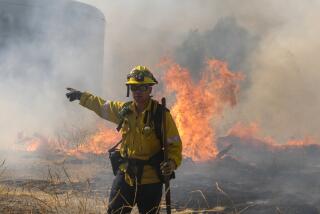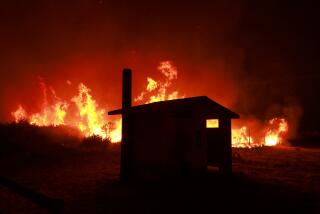Timing Catches Officials by Surprise : Flood-Plain Liability Shifted to Municipalities
Cities in the vast “100-year flood” plain of the Los Angeles and Rio Hondo rivers must immediately begin requiring builders to elevate new structures above flood levels, or the cities will be liable for damage to those buildings in case of flood, federal spokesmen told officials at a briefing on flood insurance Tuesday.
If that warning is heeded, revised building codes in 17 cities in the Long Beach, Southeast and South Bay areas soon will mandate that new structures be built at elevations where nothing more than parking and storage areas would be touched by a 100-year flood.
Since flood waters averaging about four feet deep would spread over most of the 82-square-mile plain, living or commercial portions of new homes and businesses would have to be constructed at elevations about four feet higher than permitted today, federal officials said.
The greatest impact would be on new buildings near the Carson Mall, where water overflowing the levees of the lower Los Angeles River would be 16 feet deep during a 100-year flood--defined as one with a 1% chance of occurring in any single year.
Officials from affected cities had known that they would have to require structures to be built above the flood plain by early 1991, when the federal flood insurance agency is expected to formally adopt redrawn maps defining a plain encompassing all or part of the 17 cities.
But they were caught by surprise Tuesday when Raymond T. Lenaburg, spokesman for the Federal Emergency Management Agency, told them that as of this week’s notification of the revised flood plain “the liability is on you.”
Federal regulations require local jurisdictions to make building codes conform with the best flood information available, he said. “If you let them build” under current codes, “therein lies the liability,” he told city officials.
In an interview later, he added: “We’re saying this is the best information available, guys. You should be doing this.”
In fact, the federal flood insurance agency has sued cities it concluded did not responsibly react to new flood projections, he said. In a case settled recently, San Jose reimbursed the flood insurance agency for $1 million the agency paid out for flood losses it claimed were the result of city policies, Lenaburg said.
Some local officials were unsettled by what they heard.
“Until this meeting, I labored under the impression that this was final when the final map was approved (in 1991),” said Councilman William De Witt of South Gate. “But we have been put on notice here today. And it’s kind of a shocker to me.”
De Witt said he would ask South Gate’s city attorney to respond to Lenaburg’s interpretation of municipal liability. The issue could have an impact on pending construction of a $25-million shopping center there, he said.
George Schultz, city engineer in Carson, said the elevation requirement could dramatically slow commercial and industrial construction in his city, which has large stretches of undeveloped land that would be under eight to 16 feet of water in a 100-year flood.
“Do you build them on stilts? You can’t elevate (buildings) to 16 feet. That’s why it’s such an unreasonable requirement,” Schultz said. “We’re in such bad shape I can’t believe it.”
Schultz also challenged another aspect of the federal flood insurance program, a provision that requires not only that new buildings be elevated but that they also buy flood insurance. Flood insurance on a new single-family home purchased with a $185,000 loan, for example, would cost $252 a year even if constructed to the level of a 100-year flood.
“Once you elevate, you shouldn’t have to have flood insurance at all,” he told Lenaburg during the briefing.
“That’s the requirement of the program. . . . That’s the law,” Lenaburg responded.
“Then the program’s not fair,” Schultz said.
In addition to elevation requirements, the nationwide program requires flood insurance on properties that are purchased with federally insured loans and are included on final flood plain maps. Some lending institutions even begin to require the insurance once preliminary maps, such as those distributed this week, are released, federal officials said.
Insurance Requirements
The federal insurance is required on existing properties only when they are sold or refinanced or when owners make improvements worth 50% of their market value. Flood insurance on existing homes purchased with a $185,000 loan would range from about $240 to $530 a year, depending on risk, Lenaburg said. The large majority of existing homes in the 17 cities qualify for the $240 rate.
Though some city officials have expressed concern that the flood insurance requirement might drive down the value of homes, that has not occurred elsewhere, Lenaburg said. “You really don’t see a change,” he said.
All insurance requirements will be in effect in less than two years, Lenaburg said. They would be repealed when a $300-million, flood-control project is in place, though that probably will not be before the year 2000, said a spokesman for the U.S. Army Corps of Engineers.
The corps proposes to stop a 100-year flood by building concrete walls up to five feet high atop levees along 21 miles of the lower Los Angeles River and the Rio Hondo.
Such a flood, though having a 1% chance of occurring each year and a 65% chance of occurring every 100 years, has not struck Los Angeles County this century.
One is most likely to occur in Los Angeles County, say Army engineers, during a storm that would drop 10 inches of rain over a 24-hour period, including one outburst of six inches in a six-hour period.
Close Call
Engineers say Long Beach was just one storm away from a 100-year flood in 1980, when six closely bunched storms raised churning waters to the top of the Los Angeles River channel.
The result of a 100-year flood in the county would be a blanket of water covering 82 square miles and causing $2.25 billion in damage to 120,000 buildings. The homes of about 625,000 people would be damaged, engineers say. Flood insurance officials, whose estimates are based on complete washouts of existing levees, say the waters would be three to 16 feet deep. The Corps of Engineers, which assumes that many levees will hold, estimates depths of two to eight feet.
While small parts of the San Fernando Valley and downtown Los Angeles would be inundated, the bulk of the devastation would be in communities that straddle the lower Los Angeles River and Rio Hondo south of the Whittier Narrows Dam, federal engineers have concluded.
After the briefing, some city officials picked up model ordinances for altering building codes. Others arranged for detailed briefings in their cities.
Engineers from Montebello and Pico Rivera, seeking alternatives to flood insurance, asked if they might build walls atop the levees of the Rio Hondo for the five miles it flows through their cities.
However, a spokesman for the corps said construction of taller levee walls by individual cities is a “Band-Aid approach” and would cost the two cities about $75 million.
Cities represented at the briefing were Bell Gardens, Carson, Cerritos, Compton, Downey, Gardena, Lakewood, Long Beach, Montebello, Paramount, Pico Rivera, Signal Hill, South Gate and Torrance.
No representative of Bellflower, Lynwood or Los Angeles attended, federal officials said.
More to Read
Sign up for Essential California
The most important California stories and recommendations in your inbox every morning.
You may occasionally receive promotional content from the Los Angeles Times.









